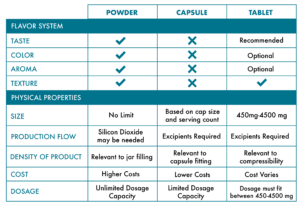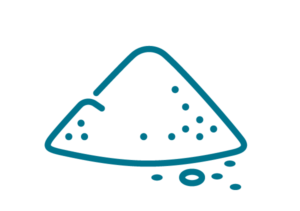Powdered Supplement Vs Ready to Feed

The Differences Between Powders, Capsules, & Tablets
Dietary supplements can come in various different applications. At Lief, we manufacture supplements in the form of powder, capsules, and tablets. One of the keys to creating a great supplement is choosing the application that optimizes and complements the supplement's formula.
Using the table below, compare how the flavor system and physical properties of the supplement vary depending on the chosen application.

As an example, let's create an "Immunity Mushroom Product" in all three types of applications.
Powder
When formulation marketable and quality powder, the most important aspects are:
Taste:
- A complex flavor system (sweeteners, maskers, acids, flavors, & gums) is used to mask or cover the "sour, bitter, fishy, or earthy" tasting ingredients in the blend.
- Using our example, to mask the taste of mushrooms, it would be best to flavor the Immunity Mushroom product as either chocolate or orange. These two flavors help cover the earthy taste of mushrooms.
- Using sweeteners and bitter blockers also help to alleviate the bitterness.
Texture:
- Some raw materials are gritty like sandpaper. This is unpleasant on the tongue.
- Gums like xanthan or guar are needed to smooth out the texture of the actives.
Solubility:
- Mushrooms can easily dissolve in either cold or hot water.
Cost (Higher Costs):
- A strong flavor system (sweeteners, maskers, acids, flavors & gums) can cost anywhere between $0.20 – $0.80.
- So, understand that if the active dosages are high, then there needs to be a strong flavor system to cover the taste from the large quantity of actives.
Color:
- Nobody wants to drink a brown "uncolored" mushroom drink.
Color affects our taste preferences significantly. - If this product is an orange flavor, then we need to add color using natural orange & yellow colors like (annatto, beta carotene).
- Without the orange color, psychologically the consumer will not interpret it as orange flavor.
- Avoid adding ingredients like spirulina (which is a "blue-green" color) to this Immunity product, because it will make the product appearance unpleasantly dark bluish-green.
Aroma:
- Just like color, aroma affects our tasting preferences as well.
- For example, Omegas 3 and 6 have a strong fishy odor. So, flavors like lemon or mint are used to mask the smell.
Good Production Flow (Using Excipients):
- The use of free-flowing agents like silicon dioxide may be needed to prevent hydroscopic clumping over time.
Dosages (Unlimited):
- In a powder blend, one has plenty of room to use beneficial & efficacious doses of each raw material.
- Unlike capsules, a powder blend does not have a min or max space capacity.
- But keep in mind, the higher the dosage, the more expensive the product will be.
Capsules
When formulating marketable and quality capsules, the most important aspects are:
Serving Size & Total Weight of Blend (Limited Dosages):
- Making sure the total blend fits in the capsule (limited raw material dosage based on capsule size and serving size).
- For example, we might only be able to keep 400-500 mg of the immunity mushrooms in for a 00 capsule with a serving count of two capsules.
Good Production Flow (Using Excipients):
- It is important to use the necessary excipients to create a good quality production with excellent flow properties.
- If the product flow is slow and poor, then the manufacturing cost increases.
- More important without excipients, the product is never consistent.
Density:
- Botanicals are very light and fluffy, which make it difficult to fit the entire amounts into a capsule.
- Referring to size limits, we may only be able to fit 400-500 mg of the mushrooms per 00 capsule, because of their light and fluffy nature.
Cost (Lower Costs):
- Cost is easier to maintain in a capsule because there is limited space.
- Capsule applications do not need to use a "flavor system", so that lowers cost as well.
Dosages (Limited):
- Because you are capped on the amount of raw materials you can fit into the capsules, this application cannot hold large quantities of each raw material.
- Mainly focus on one "star ingredient" and the other ingredients can be used in much smaller quantities.
Tablets
When formulating marketable and quality tablets, the most important aspects are:
Total Weight of Blend:
- The typical range of tablet size is between 450-4500 mg.
Solubility:
- A tablet must be able to disintegrate/ dissolve in less than 30 minutes.
- This mimics the digestion cycle when a tablet is swallowed and brought to the stomach.
Color (Optional):
- Tablets can be colored used coating techniques.
- Currently, the average consumer accepts the natural color of a tablet without the need for a "colored coating".
- For an Immunity Mushroom tablet, even if the natural color is brown consumers are more accepting of the natural color.
Good Production Flow (Using Excipients):
- It is important to use the necessary excipients to create a good quality production with excellent flow properties.
- If the product flow is slow and poor, then the manufacturing cost increases.
- More important without excipients, the product is never consistent.
Dosages (Varies):
- Since the tablet size ranges from 750-4500 mg, there is plenty of room for either small or large dosages.
Density:
- Botanicals are very light and fluffy, which makes it harder for the tablet to bind and compress.
Taste:
- Taste is important, regardless if the tablet is chewable or swallow.
- It is important that the aftertaste is not medicinal or bitter.
- For example, Orange flavor can still be used in an Immunity Mushroom tablet.
Texture:
- Swallow tablets must be hard.
- Chewable tablets must be softer, but still hard enough to stop the edges from chipping off during transportation.
Cost (Varies):
- Costing for tablets is dependent on many factors:
- Amount of active raw materials
- Whether a tablet-coating is used
- If a flavor system is used
- How much binders and excipients are needed based on the formula
- Overall, tablets require a less complex flavor system compared to powders, so that lowers the cost.
Source: https://lieflabs.com/the-differences-between-powders-capsules-tablets/



0 Response to "Powdered Supplement Vs Ready to Feed"
Post a Comment